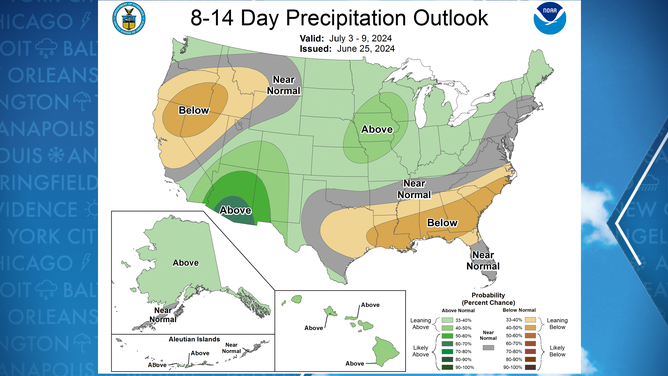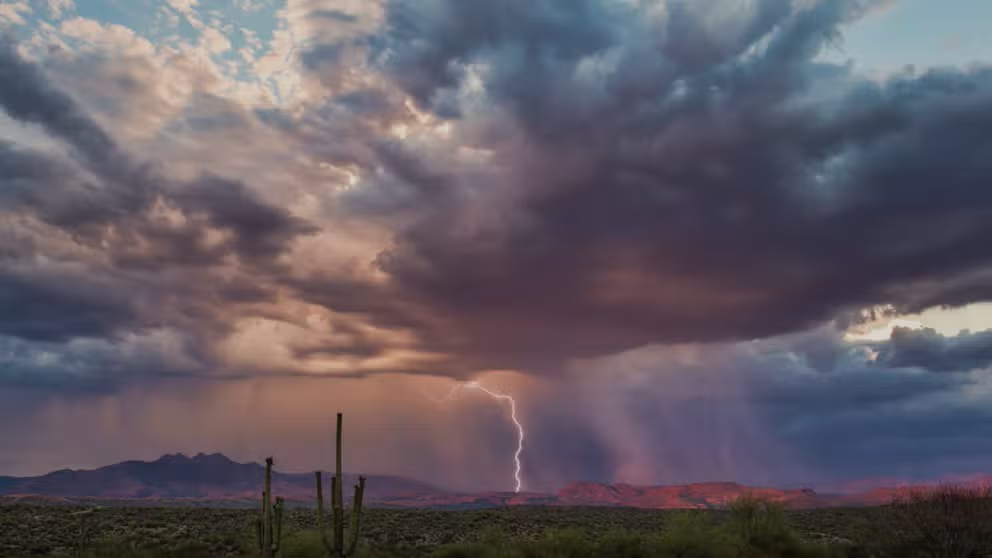Southwest monsoon season shows signs of life after sluggish start
Overall, cities in the Southwest roughly accumulate half of their annual precipitation during the months of June, July, August and September but amounts vary significantly. The Southwest monsoon season kicks off June 15 and lasts through late September.
7 Facts About Monsoon Season
Here are 7 facts about monsoon season.
A ridge of high pressure over the southeastern U.S. will result in an increase in monsoonal moisture for the Desert Southwest, which has been scarce across the region as of late.
Forecast models indicate widespread rainfall of 1-2 inches over the next two weeks, with isolated communities potentially receiving significantly more.
The moisture is expected to stream in from Mexico as a flow out of the south and southeast works its way over cities in Arizona, New Mexico, Texas, Colorado and Utah.
Not everyone will see an increase in precipitation, but where the rains fall, they could be quite heavy, with concerns for flashing flooding and debris flows.

Precipitation outlook for next 14 days.
SOUTHWEST MONSOON SEASON IS HERE: WHAT YOU NEED TO KNOW
The Southwest monsoon season annually kicks off on June 15 and lasts through late September, but its activity varies dramatically year by year.
The region typically sees half of its annual precipitation during these months, which is vital for the replenishment of water resources and the survival of ecosystems.
According to National Weather Services offices in the Southwest, this figure can vary from as little as 20% of a community’s annual rainfall in western Arizona to more than 70% in New Mexico and West Texas.
"After two fairly wet monsoon seasons in 2021 and 2022, a complete reversal was observed for the 2023 Monsoon with much drier than normal conditions across a large portion of the southwestern U.S., especially across central and southern Arizona into New Mexico and west Texas," NWS meteorologists stated.
Despite the down year, it did not prevent scenes of flash flooding from taking over streets around Las Vegas and stranding more than 73,000 attendees at the annual Burning Man festival in northwestern Nevada.
Torrential monsoon rains send muddy water rushing through Las Vegas
Video filmed by Dwayne Scales of StormRunner Media shows a bus stranded on Lake Mead Boulevard in Las Vegas and a whirlpool forming near Interstate 15. (Credit: StormRunner Media via Storyful)
LAS VEGAS ROADS SWAMPED AS MONSOON THUNDERSTORMS TRIGGER FLASH FLOODING
By most accounts, the 2024 monsoon season is expected to be a down year for moisture, as the ingredients simply aren’t in place for any type of widespread record-breaking event.
Tropical activity in the Pacific is reduced due in part to a neutral or even La Niña status of the El Niño Southern-Oscillation and the location of ridges of high pressure do not correlate to frequent impulses of moisture.
The FOX Forecast Center will be closely monitoring areas with burn scars created by recent fires, especially around Ruidoso, New Mexico.
Wildfires such as the South Fork and Salt have consumed more than 25,000 acres and have left the terrain vulnerable to heavy rainfall events.
The loss of vegetation, combined with the soil’s increased ability to repel water, has historically led to significant runoff events, which overwhelm drainage systems and lead to mudslides and flash flooding.
For most of the Southwest, the wet weather typically subsides by mid-September, giving way to a much drier weather pattern until high-elevation snows begin during the winter.

